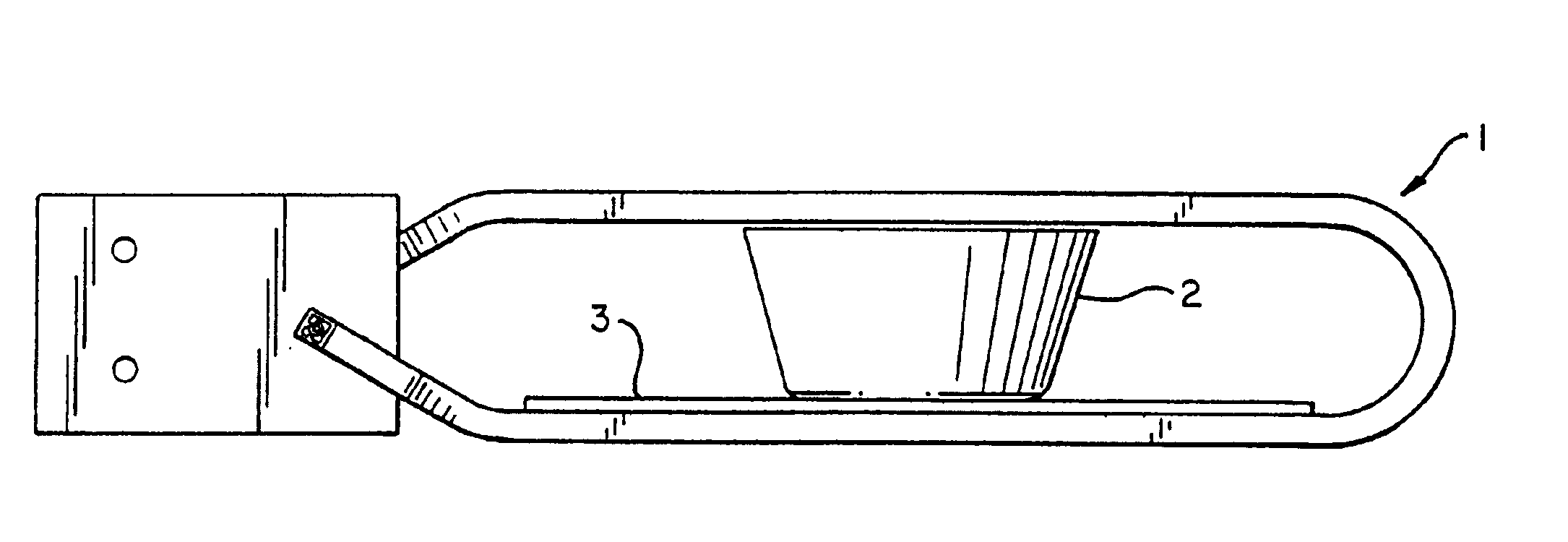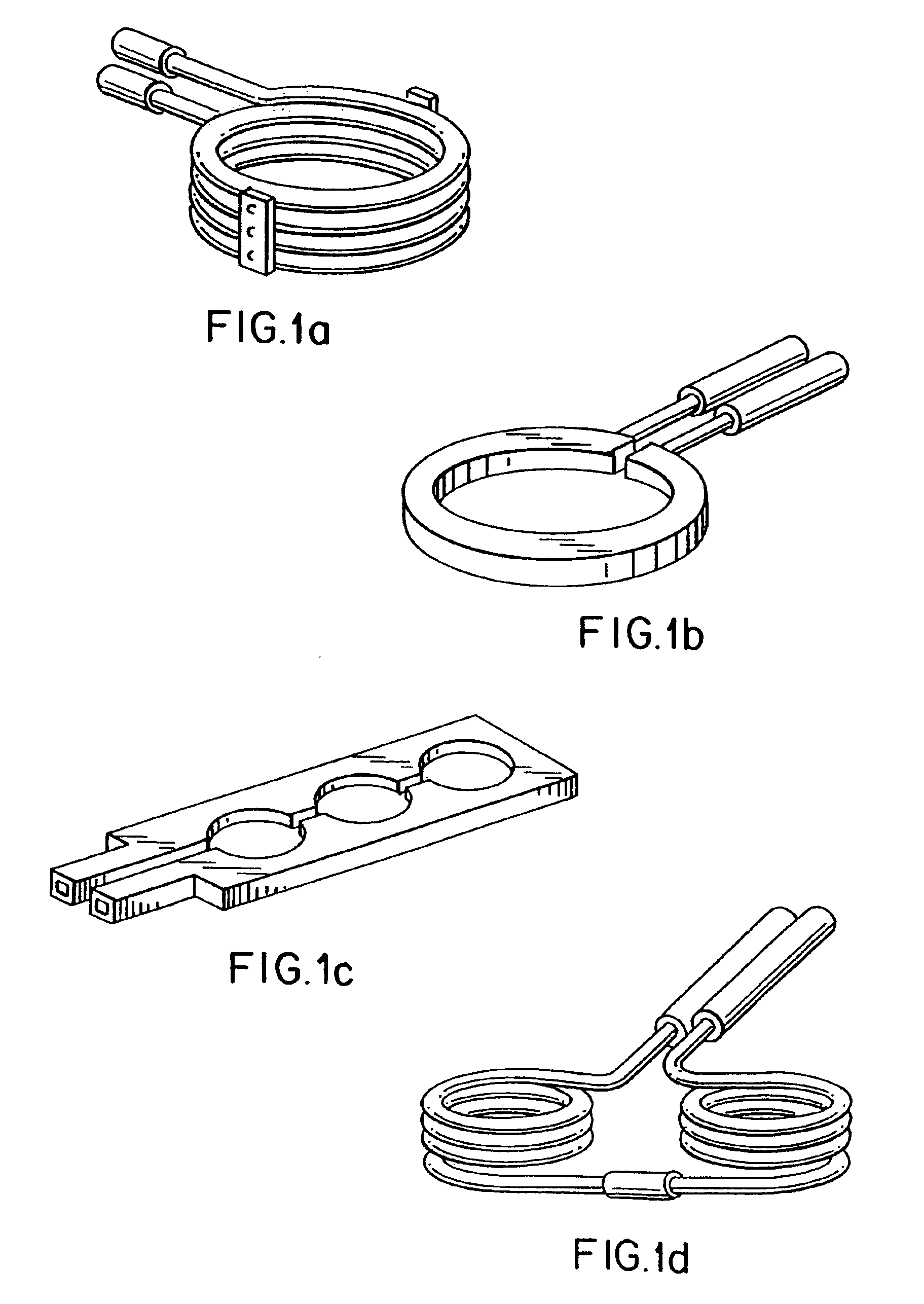Adhesive or sealant composition including high efficiency heating agents and methods of use
a technology heating agent, applied in the field of adhesive or sealant composition, can solve the problems of heat dissipation efficiency, and achieve the effect of high heat dissipation efficiency, high heating efficiency and efficient operation
- Summary
- Abstract
- Description
- Claims
- Application Information
AI Technical Summary
Benefits of technology
Problems solved by technology
Method used
Image
Examples
example 1
Category L Coil—Hairpin Coil
Test Procedure and Criteria
[0080]A single turn coil of 5 / 16 in. square copper tubing in the shape of a hairpin (FIG. 3—side view & FIG. 4—top view) 262 mm in length with 51 mm between the legs of the coil (1) was selected as representative of a Category L coil.[0081]Because the intent was to determine the efficiency with which a candidate heating agent generated heat, regardless of the shape of the agent or random variations due to inconsistencies in distribution, mineral oil was selected as the medium to be heated. The oil allowed for rapid equalization of the temperature by stirring and its temperature rise was reflective of the total heat generated. The data generated can be applied to any matrix from solid to liquid and from high density to low.[0082]3 g of heating agent was combined with 60 g of mineral oil and evenly distributed across the bottom of a 150 ml Pyrex® cup (2).[0083]The coupling distance between the heating agent and the coil would, aga...
example 2
Category S Coil—Solenoid Coil
[0131]In the Background—Description of the Prior Art a distinction was made between two general categories of applications of the alternating magnetic field heating of heating agents, Category S applications and Category L applications.
[0132]It was also indicated that the patents of Monovoukas U.S. Pat. No. 5,378,879 (1995) and Berce U.S. Pat. No. 5,447,592 (1995) were directed to applications of, or tested in coils falling into, the Category S class. As discussed in the analysis of the results of tests in Example 1, the heating efficiencies found in the Example 1 tests were in many instances dramatically the opposite of those found in Monovoukas and Berce. This suggests that the results and conclusions of Monovoukas and Berce, while accurate for Category S applications, do not hold true for Category L applications. Moreover it suggests that the test setups and methodologies of Monovoukas and Berce masked the far higher efficiencies of the species of fib...
example 3
Plastics Welding
[0153]The high efficiency fiber heating agents of the present invention have major advantages over the prior art heating agents in a wide variety of applications, some of which were outlined in the Background of the Invention. The previously discussed mineral oil tests demonstrate the remarkably higher heating efficiency of the fibers of the present invention, which would apply to a similar extent to other heating applications, such as those outlined. To discuss and analyze examples from all of the potential applications would prove an unnecessarily monumental and repetitive task resulting in an unmanageably long patent application, therefore one representative application was chosen to illustrate the correlation between the results generated in the mineral oil tests and the practical applications.
[0154]Of the applications, the most industry experience and prior art has been directed toward the use of heating agents for the welding or bonding of plastics, therefore t...
PUM
| Property | Measurement | Unit |
|---|---|---|
| Fraction | aaaaa | aaaaa |
| Fraction | aaaaa | aaaaa |
| Fraction | aaaaa | aaaaa |
Abstract
Description
Claims
Application Information
 Login to View More
Login to View More - R&D
- Intellectual Property
- Life Sciences
- Materials
- Tech Scout
- Unparalleled Data Quality
- Higher Quality Content
- 60% Fewer Hallucinations
Browse by: Latest US Patents, China's latest patents, Technical Efficacy Thesaurus, Application Domain, Technology Topic, Popular Technical Reports.
© 2025 PatSnap. All rights reserved.Legal|Privacy policy|Modern Slavery Act Transparency Statement|Sitemap|About US| Contact US: help@patsnap.com



